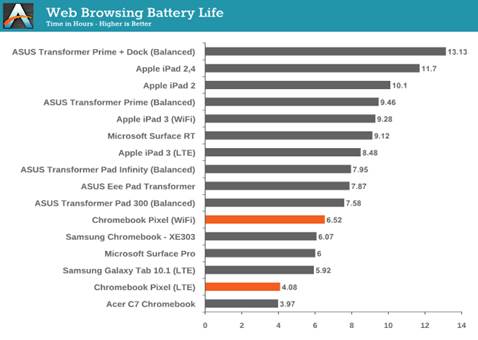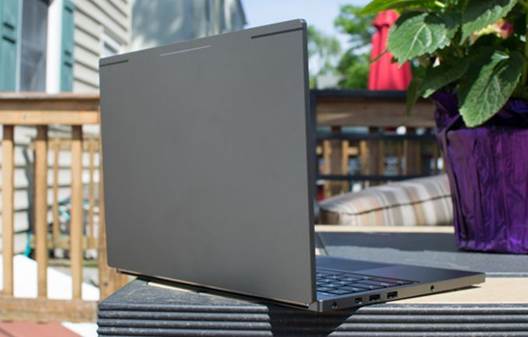Battery life
As the performance tests of our, the
battery tests borrow much from the tablet reviews rather than the laptop
reviews. The lack of ability running any particular software here limits us
with the browser. So, we start with a web browser test. The idea is easy to
understand, we cycle through the websites, disable any services that may
disrupt the process and set the screen to brightness 200 nits. This test is
designed to test the ARM cores, for them enough time to render the page and go
back to sleep before the next page requests. This is not very difficult with
Ivy Bridge chip, which can be completed render and in sleep mode much faster,
which we know to make the average energy consumption and better battery life.
Another factor that affects the battery life in this scenario is that screen.
With more than 4 million pixels, the screen will consume energy faster.

Web
browsing battery life
Pixel creates 6.5 hours on Wi-Fi, beats Surface
Pro a little, but additional capacity of larger batteries is exhausted by the
screen to consume more energy. On LTE, Pixel has 4:08 hours, enough for a few
hours at the cafe, but not enough for all day session.
Our video test loops a 720p video that encodes
with H.264 with an average bit rate of 4Mbps and screen is set at 200nits
tradition brightness. Run this test on the Chromebook is slightly different
than any other platform. Video player does exist outside the browser, but the
software is written in HTML5. However, the decoding H.264 content is a major
factor of Chrome and HTML5. Right?

Video
playback-H.264 720p high profile (4Mbps)
This is truly amazing performance and
amazing. Best explanation that we can offer, the problem in video player is
that this file prevents using hardware decoding resource. In that case, the
decoding and the scaling video fitting the screen may require heavy system
enough to cause this poor performance. If that is the case, then one update can
improve this point significantly, however, until then, Pixel does not create a
good media companion on the road.
After all, what you really see in these
charts that is the advantage that Ivy Bridge has over ARM not enough to beat
the ARM power. Pixel Chip is a 17W part. Even ARM SoC consumes the most energy
in this table is below 5W. That amount is difficult to overcome deficiencies in
the moment. There is one very real reason to be careful when buying anything
this time with Ivy Bridge. Anand encounters similar cases in a Surface Pro
review. Another Haswell option in the future brings better battery life, with
comparable performance. There is also the Atom refresh (Silvermont) to
consider; a quad core Baytrail component can provide plenty of performance while
using less energy than Ivy Bridge component that we are using today.
Pixel will let you sit in the park all day,
read the great American novel? No. Alas, you may not watch long movies during
the flight. If battery life is the main concern, look elsewhere to use
Chromebook. If you are near the outlet, this performance is not great. When you
design one thin laptop, modern, you have to make compromises, and in this case,
the battery life is one of them.
Conclusion
Something magical happens during the
writing of this article. I know many of us have been waiting for it, and we
apologize for this delay. But really, it's worth. I spent a few weeks with
Pixel when it entered the bowels of Anand’s lab to analyze it. I used that time
to write much of what you read. My conclusion is somewhat complicated, but the
general is this: if you want Chrome OS successfully, you can use it now, and
MBP Retina-sized money to spend, you should buy it.
The operating systems change and improve,
it is nothing new. These fixes and updates are designed to improve the village,
smoothing rough and additional functionality. In general, this is what happened
in many months, if not every year. But just a few weeks, the Google team has
brought a lot of bug fixes and features than I wait, and rewrite my review. And
perhaps, it is the perfect introduction to this review, a testament to the fact
that if nothing else, when you buy the Chromebook, you're buying something that
will get better any other operating systems you've used before.

The
operating systems change and improve
The user experience is still limited. Some
people joke that Chrome OS should paste the huge Beta tag on the side, indeed,
those who oppose this may have a point. If that is true, the value of your $1,300
investment is not in silicon, lithium-ion battery, metal frame as well as the
screen, the real value of Pixel lies in the potential coming with a platform
provides nearly every hardware features that we may require. Chrome OS
continues to improve, with regular updates affect all aspects of the software.
The preinstalled apps, Native Client and asm.js are new techniques to bring
more applications beyond the browser, while the APIs as WebRTC, WebGL and
WebAudio allow many more complex applications built entirely in the browser.
Indeed, the future of Chrome OS seems to be reinforced by the more dominant of
the web application that was introduced by Google at I / O. One of the most
interesting things appear throughout the speech is the expanding services across
all platforms. Multiplayer games can be played in iOS, Android or any Chrome
browsers. The messages can be answered or deleted in your browser, and are
recorded as on the phone. All are enabled through the services and combined
that users should not interfere.
This is one possible future. It can also
feel wobbly for years, unable to get enough momentum to attract developers
which will help Chrome OS becomes competitive. Or, real dagger in the Chrome OS
heart will be the Chrome. When computing becomes cheaper, the demand for a free
operating system promotes faster and smoother web experience that will
disappear. I did not know it could go any ways, but I want to be a part of it.
And I think it is the main criteria that the buyer should consider. If you are pressed
by the view as a web platform, this is the laptop for you.

If
you are willing to abandon all other platforms, and start with just Chrome by
your side, then you will not find a better option than Chromebook Pixel.
However, the battle lines are not for
everyone. There will never be many buyers for Pixel, and Google always find ok
with it. Though they design this to serve a particular market segment, it faces
competition. The stiffest competitor comes from an unexpected place: the
13-inch MacBook Pro with Retina screen. Starting with $1,499, it's just more
expensive than LTE model we are currently testing a little, and not too high when
compared to the basic Pixel model. With the additional money, you have one
powerful operating system with current application ecosystems can serve the
most demanding users. And that's really strong argument, any applications you
like, not just the promise of a bright future of the web applications. Google
plans to bring all the features of Chrome to all platforms, so the success of
the web as a platform that can be available to all. So, if you are not already,
consider rMBP. On the other hand, if you are willing to abandon all other
platforms, and start with just Chrome by your side, then you will not find a
better option than Chromebook Pixel.